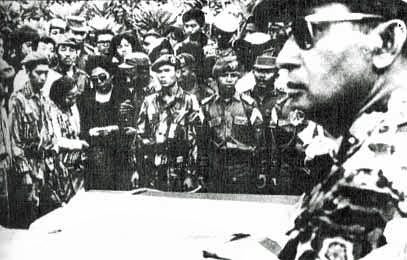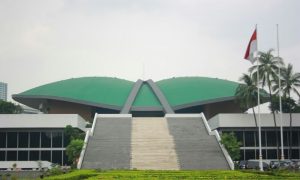The following text is also forthcoming in Indonesian with Forum 100 Ilmuwan Sosial Politik LP3ES.
In part 1 Prof. Törnquist outlined the methods of leftist repression that characterised Suharto’s early efforts to gain power. Part 2 describes the obstacles faced by those who have sought to revive the left in the decades since.
Abandoned anti-colonial strategy
The focus on equal citizens’ rights and democracy as a unifying framework for class struggle and democratisation of the state apparatus—which until 1958 had been almost as successful in Indonesia as in the Indian state of Kerala—had been jettisoned in favour of Guided Democracy. So the Communists’ and the broad progressive movement’s political and cultural hegemony was only on the level of general ideology and rhetoric, and lacked sufficient power in the “trenches” and “permanent fortifications” to rein in the military and their allies through democratic means.
Dynamics of oblivion
In what way did this continue to be important? How does it matter today? The miscalculations were certainly swept under the carpet during the salad days of Guided Democracy. More interestingly, after the genocide, the dominant Maoist critics suggested armed struggle rather than a return to democratic priorities. In spite of their own quick failure, they were also unwilling to interrogate the signs that anti-imperialism was insufficient to undermine the military and others who captured public assets and resources. Neither, of course, were the Maoists interested in problematising their thesis that radical struggle for land reforms, such as in Indonesia, would unify the rural poor. These deadlocks affected other leftist leaders too. Generally, the Left was in disarray and unable to provide any innovative guidance.
In addition, in the 1970s, new dissenters certainly focused on corruption, but were more in favour of Singaporean than democratic alternatives. And when they subsequently joined a new generation of students in critique of the transnational corporations that had flooded the country, the insights from the 1950s of how to come to terms with the remnants of colonialism and indirect governance were deemed obsolete. This was because in the view of the new Latin American theories of dependency, capitalism was deemed hegemonic and it was necessary to focus on socialism—along with NGO support for “the victims” and human rights. From the late 1980s, innovative younger socialists certainly concentrated more on resisting the political, state and military bases of capitalist expansion—as well as on mobilising people outside NGOs and university campuses. But the perceptive and brave activists were more interested in opposing Suharto’s regime than reclaiming the demoted primacy of broad democratic movements with social rights in the forefront—even though old adversaries like liberal Marxist intellectual and renowned publisher, Goenawan Mohamad, joined forces with nationalist Marxists, Joesoef Isak and Pramoedya Ananta Toer, to stress its urgency. The lacuna remained in spite of efforts at investigative journalism and participatory studies of substantive democratisation (which I had the privilege of taking part in).
Indonesia's most important writer tells the youth to take control of the nation's future.
Pramoedya’s Message to the Youth of Indonesia
Hence, the fragmented progressive groups which tipped the balance with massive demonstrations towards the end of Suharto’s rule were neither able to develop a popularly anchored economic policy as an alternative to the authoritarian neoliberal management of the Asian economic crisis that hit Indonesia particularly hard, nor propound a realistic alternative to elitist democratisation. While some progressives therefore joined the elitist mainstream, others returned to activism in civil society and unions. They typically engaged in lobbying and horse trading with politicians, or linking up with auxiliary public commissions such as for human rights and against corruption. Mass-based democratic politics for citizens’ rights remained a blurry distant dream. Until, that is, there was an opening to firstly negotiate labour and welfare reforms with popular local politicians in need of support to win elections, such as Jokowi, and secondly to build broad alliances with parliamentarians such as for the national health scheme. Yet there was no real effort at a transformative series of reforms, or at democratic institutionalisation of the new participation and negotiations. So, when it was necessary from the mid-2010s to weather the resurgence of conservative strongman-populism along with Muslim identity politics, no viable progressive alternative to elitist transactions, accommodation of military leaders and indirect governance through pragmatic Muslim leaders existed.
One step back to move ahead
The analysis suggests, thus, that as the third wave of democracy has now petered out, and authoritarianism along with indirect rule and identity politics is on the offensive, it is more important than ever to recall the historical insights on how to counter it. The focus must be broad alliances for equal civic, political and social rights, by democratic means—to generate real political clout rather than relying on mouthing empty slogans in defence of democracy and human rights. Just as the mainstream amnesia about the genocide has to be revealed, the other precondition is that the Left’s oblivion of its own history is also addressed. It takes time, but it is not too late. The suppressed Left in Europe did not return to the fore after the Second World War until it revisited its history—recalling past insights and lessons, and certainly adding studies of new conditions. In Germany, for one, it took until the 1960s until new progressive movements blossomed and paved the way for 1989. Similarly, the more recent critiques of Blairite neo-liberalisation of social democracy, and the new democratic socialists in the U.S., have gained steam by revisiting the 1930s’ breakthrough of Keynesianism and social citizenship with New Deals and welfare states. There are no fixed models from before to bring alive. Old nationally confined social democratic models, for example, must be internationalised to counter neo-conservative nationalism. But just as the Renaissance from the 14th to the 17th centuries overcame the dark Middle Ages by reappraising classical insights, critical history is now imperative.
 Facebook
Facebook  Twitter
Twitter  Soundcloud
Soundcloud  Youtube
Youtube  Rss
Rss 



